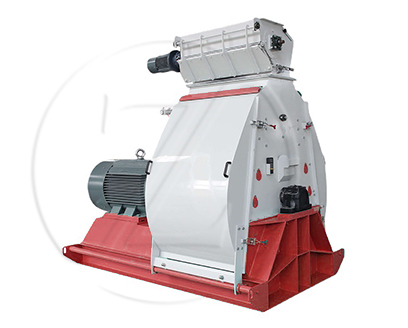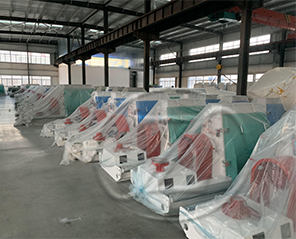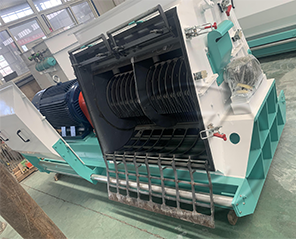- Zhengzhou City, Henan Province China
- Telephone: 0086-16637162658

⚪Customization&OEM
⚪ Tailored Solutions, Customized Plans.
⚪Install with precision and expertise.
⚪Support throughout and beyond.
Introduction of Water Drop Hammer Mill:
The Water Drop Hammer Mill is suitable for grinding corn, soybeans, wheat, and grains. It is especially suitable for the crushing of pig feed, fish feed, poultry feed, and livestock feed. Widely used in industries such as animal feed processing, brewing, chemical, and biology.
Why Use Water Drop Hammer Mill:
1.The main unit features a user-friendly design, facilitating easy control and reducing noise levels.
2.The crushing chamber is designed reasonably, increasing the material's sieving rate.
3.Easily achieve both coarse and fine crushing functions, enhancing crushing efficiency.
4.Adjusting the hammer-screen clearance allows for either coarse or fine crushing, achieving dual functionality in one machine.
5.The fully open shift operation door facilitates maintenance and blade replacement.
Working Principle of Water Drop Hammer Mill:
Grinding equipment hammer mill consists of a delivery device, hammers, screen, rod, and rotor on which hammers are mounted. The hammers swing freely on the central rotor. When material is fed into the hopper, the rotor rotates at high speed.
The material is impacted by the hammers, thereby being ground, and then discharged through the screen in a selected size.
Application
The Water Drop Hammer Mill has a wide range of applications, primarily in the following areas:
1.Animal Feed Processing: Used for crushing and processing feed raw materials such as grains, legumes, and corn, providing suitable granular feed for livestock and poultry.
2.Wood Processing: Suitable for crushing wood particles like wood chips and wood shavings, applicable in the production of biomass pellet fuel and wood particle board.
3.Food Processing: In the food industry, it can be used for crushing grains, legumes, and other food ingredients, providing raw materials for food processing.
4.Brewing Industry: Used for crushing brewing raw materials such as barley to facilitate subsequent fermentation and brewing processes.
5.Chemical Industry: Applicable for crushing chemical raw materials to meet the requirements of different processes.
6.Biomass Energy Production: Used to convert biomass materials like straw and wood chips into granular biomass fuel.
7.Forage Processing:Used for crushing forage to prepare feed or produce granular forage.
8.Fertilizer Production: Used for crushing fertilizer raw materials to meet the preparation needs of different fertilizer products.
In summary, the Water Drop Hammer Mill plays a significant role in various industries, including agriculture, livestock, food, wood, energy, and chemical sectors.
Technical Parameters
|
Model |
Power(kW) |
Capacity(t/h) |
|
SFSP56*40 |
30/37 |
2-6 |
|
SFSP60*60 |
45/55 |
5-15 |
|
SFSP60*80 |
75/90 |
8-20 |
|
SFSP60*100 |
110/132
|
10-30 |
The production process of feed mill :
The Feed Milling Process typically involves the stages of raw material reception and storage, cleaning, crushing, dosing & mixing (batching), pelletizing, cooling, pellet refinement, screening & grading, packaging, and storage.
In specific cases where clients have unique requirements for feed pellet production equipment, additional features such as liquid infusion, curing, spraying, extrusion, drying, and more may be integrated.

Do you know the production process of a feed manufacturing plant?
1.Raw material storage :
Given the diverse array of ingredients in animal feed, various types of silos are essential. The feed pellet production line can employ three types of silos, namely hopper silos, flat-bottom silos, and galvanized silos.

Primarily employed for eliminating impurities from feed raw materials, particularly large, medium, and ferrous impurities, aiming to achieve the following objectives:
○ Safeguarding both equipment and workers,○ Enhancing the quality of feed products, and ○ Ensuring secure and efficient equipment operation.
In accordance with the process flow and raw material composition of feed production, it is necessary to crush the raw materials to the required particle size.

4.Dosing equipment:
mainly used for dosing various raw materials, mixing materials evenly, including manual dosing type and automatic dosing type.
mix the feed ingredients thoroughly. This stage demands short blending cycles, high mixing quality, rapid discharge, low residue rates, excellent airtightness, and zero dust spillage.

6.Pellet Mill:
This process is to press out the pellets, the finished pellets are good palatability, storage resistance, there are two kinds of flat model and ring model, feed mills mainly use ring die pelletizing machine.

7.Cooling Equipment:
When pellets are extruded from the pellet machine, their moisture content reaches approximately 16%, and the temperature can reach 80-90 degrees Celsius. To facilitate pellet storage, the cooling process is indispensable.
8.Pellets Crusher / Breaker / Bucker :
Break the pellets into small particles.It is mainly used for chicken feed pellet line.
9.Screening Equipment:
After the pellet feed undergoes the crushing process, certain undesired materials such as powder are generated. This process primarily involves separating the non-conforming pellets and powder, allowing the qualified pellets to proceed to the next stage of production.
This includes both automatic packaging machines and manual packing machines.

11.Dust Removal Equipment:
Essential for eliminating dust and ensuring environmental protection.
12.Conveyor: for conveying feed ingredients, semi-finished and finished feeds
Real Shot



Get An Instant Quotation For all inquiries fill in the form below to send us a brief message,and we will get back to you as soon as possible.
Henan zhongzhenxing Machinery Equipment Co.,Ltd. Your dedicated partner in custom feed processing solutions. With a rich legacy spanning over a decade, we specialize in tailoring comprehensive equipment sets to meet the unique production needs of small, medium, and large-scale feed operations.